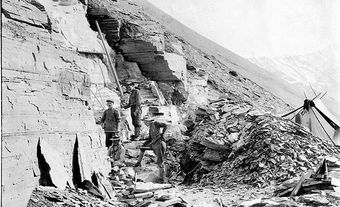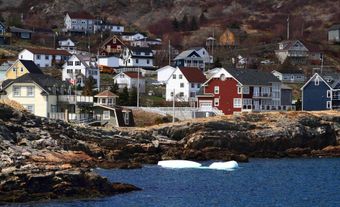Mistaken Point was designated as Canada’s 18th World Heritage Site by the United Nations Educational, Scientific and Cultural Organization (UNESCO) in 2016. It is located in southeastern Newfoundland. Mistaken Point is the oldest grouping of large, biologically complex fossilized creatures found anywhere in the world. The fossils date from 580 to 560 million years ago, when large, multicellular organisms began to appear. Mistaken Point was the fifth Canadian fossil site to be recognized by UNESCO, following Dinosaur Provincial Park (1979), Canadian Rocky Mountain Parks (1984), Miguasha National Park (1999) and Joggins Fossil Cliffs (2008).
Geography
Mistaken Point is located on the Avalon Peninsula in Newfoundland, 150 km south of the capital city of St. John’s, near the communities of Cape Race and Portugal Cove South. The site gets its name from the fact that, in bad weather, sailors often confused Mistaken Point for Cape Race. They would turn north, expecting to find Cape Race Harbour, but would instead run into rocks. This repeated mistake led to 94 shipwrecks between 1864 and 1904. The site is now part of the 17-km-long Mistaken Point Ecological Reserve, established by the Government of Newfoundland and Labrador in 1987 to protect the fossils located along the coastline.
Discovery

Mistaken Point, Newfoundland and Labrador. Mistaken Point was designated a UNESCO World Heritage Site in 2016. It is home to a large grouping of Ediacaran period fossils.
The fossils at Mistaken Point were discovered in June 1967 by Shiva Balak Misra of India and his field assistant Paul Thompson. The two scholars were mapping Precambrian-era rocks as part of Misra’s master’s thesis for Newfoundland’s Memorial University. The Precambrian era is considered the earliest phase in the Earth’s history, dating from approximately 4.6 billion to 541 million years ago. Over 10,000 distinct fossils were identified at Mistaken Point, ranging in size from a few centimetres to nearly 2 m long. Private collectors visited the isolated site and removed some fossils with explosives and sledgehammers, while Royal Ontario Museum staff used diamond saws. Local residents of nearby Cape Race and Portugal Cove South have been leading figures in the protection of these fossils from collectors since the time of their discovery. The removal of fossils became illegal in 1987 when the Mistaken Point Ecological Reserve was established.
Geology
The fossils at Mistaken Point are from the Ediacaran period, and range in age from approximately 580 to 560 million years old. The fossils were created when animals living in a moderately deep marine environment were covered by a layer of volcanic ash. They were almost immediately preserved in their exact locations. Because of this, the fossils at Mistaken Point are almost an exact replica of the sea floor from half a billion years ago.
Fossils

Fractofusus, a type of rangeomorph, fossilized at Mistaken Point, Newfoundland and Labrador. Rangeomorphs are the most common species of fossilized organisms found at Mistaken Point, a UNESCO World Heritage Site.
The fossils at Mistaken Point are the largest collection of complex, multicellular Ediacaran-period animals anywhere in the world. Seventeen different species have been identified at this site, with the most common species being rangeomorphs. Rangeomorphs did not have muscles, mouths or guts, and fed themselves through a process called osmotrophy. Osmotrophy is when a creature absorbs organic molecules through their skin. Like many of the other species identified at Mistaken Point, rangeomorphs are an ancestral group of complex life, and are from an extinct evolutionary branch that did not lead to any modern animals.
World Heritage Site Designation
Mistaken Point was added to Canada’s UNESCO World Heritage tentative list in 2004, and was designated as a World Heritage Site 12 years later in 2016 (see United Nations World Heritage Sites). This site was recognized as an invaluable record of life at a key moment in Earth’s history. For nearly 3 billion years life on Earth consisted of microscopic organisms. The fossils at Mistaken Point illustrate the time at which these organisms evolved into larger, multicellular animals.
Visiting Mistaken Point
The nearby Edge of Avalon Interpretive Centre offers exhibits on the ancient and modern history of the Mistaken Point fossils. The fossils themselves can only be visited by guided tours in order to conserve the fossils and to monitor environmental damage.

 Share on Facebook
Share on Facebook Share on X
Share on X Share by Email
Share by Email Share on Google Classroom
Share on Google Classroom



